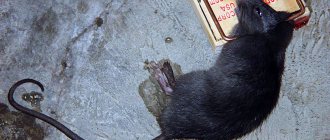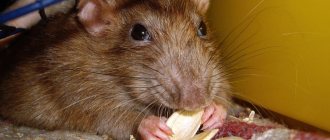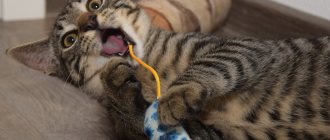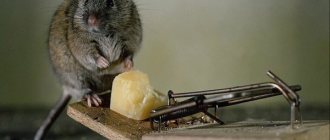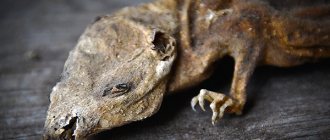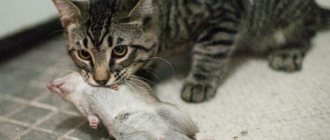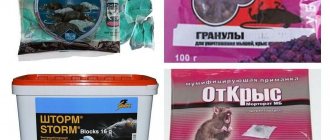The cat became the first animal that was tamed by man in primitive times. Her developed hunting instinct did not go unnoticed. Regularly caught rodents on the territory of the house and land. An animal has become a friend, a companion, a family member, and a weapon against mice and rats. The question of whether cats eat mice or just catch them is asked by many owners after unusual finds in the house. The hunter brings the caught prey to the owners, shows off the trophy, and leaves it in a visible place.
Why do cats eat mice?
Hunting and eating tailed rodents is not only satisfying the hunting instinct, but also maintaining the cat’s health, which he is trying to ensure for himself at a natural level. The fact is that the brain of mice contains a large amount of taurine, which is vital for cats. This substance plays a huge role for the animal:
- regulates the operation of the central system;
- forms strong immunity;
- normalizes the process of blood clotting, preventing the opening of internal bleeding and promoting rapid healing of wounds;
- maintains the functioning of the reproductive system at the proper level;
- is a strong antioxidant that cleanses the body;
- facilitates contraction of the heart muscle, replenishing the necessary calcium concentration.
If the level of taurine in the body drops as a result of insufficient intake from food, the animal may develop heart and vascular diseases, as well as neurological disorders. When a cat suddenly starts catching and eating mice, this is a signal for its owner that it is necessary to reconsider its diet and introduce foods enriched with taurine into the diet.
Other elements necessary for a cat - sulfonic acids, which include methionine, cystine and cysteine, are found in mouse skin. These sulfonic acids are necessary to maintain the normal condition and thickness of the cat's coat. If a cat eats a mouse along with its skin and fur, it means that it is experiencing a shortage of these elements.
Toxoplasmosis
Toxoplasmosis is one of the most common parasitic diseases of cats. This infection is caused by the parasite Toxoplasma gondii. Toxoplasmosis can affect many animals, including humans. However, the cat is an ideal host for Toxoplasma gondii because it is the only animal in which this microscopic parasite can complete its life cycle.
Cats become infected with Toxoplasma gondii by ingesting cysts of this parasite. This most often occurs when cats eat mice or rats infected with the parasite. However, they can also ingest it while grooming themselves after coming into contact with contaminated soil or feces.
Cats infected with toxoplasmosis often show no symptoms. In rare cases, cats develop lethargy, gastrointestinal problems, or even respiratory problems. Many cats will remain silent carriers their entire lives.
People can become infected with toxoplasmosis after handling cat litter containing the parasite and accidentally ingesting the microscopic cysts. They can also get it from eating contaminated meat.
Symptoms of toxoplasmosis in humans include fever, headache, lethargy and muscle pain. Toxoplasmosis may not actually cause any symptoms in people.
Warning: However, it can cause serious complications in pregnant women and people with weakened immune systems.
Satisfying the hunting instinct
Even the cutest and fluffiest kitten once played the role of a hunter and predator in nature. After people domesticated cats and began using them as pets, they no longer needed to hunt for food. However, instinct periodically takes over and requires its manifestation in domesticated conditions.
Even if a cat’s body does not lack any elements to maintain health, hunting for mice is its natural need, a reflex that cannot be restrained. Catching mice is not just the job of barn cats. Many purebred kittens living in greenhouse conditions, once they see a mouse, will definitely chase it. But whether they eat their prey for lunch or not depends on whether they are tormented by hunger.
Main breeds of rat catchers
Independent hunters are representatives of the Russian Blue breed. They become attached to only one owner, whom they are ready to protect from rodents. Athletic athletes - Chartreux cats - have a beautiful athletic physique, which helps in catching rats and mice.
Maine Coon
This ratcatcher cat is the largest breed; it is an intelligent and selective animal - a good hunter. The Maine Coon reacts with lightning speed to a rodent, and its powerful body and dexterous movements leave no chance for rats and mice. At the same time, he is a sweet and gentle creature who will purr with pleasure in his owner’s ear.
Siberian
The Siberian cat rarely becomes attached to humans, perhaps it has the “wild” blood of its ancestors. This balanced and powerful animal is considered the best rat hunter. Freedom is very important for an obstinate pet; the cat wants to walk outside from time to time. The Siberian cat is capable of developing great speed in running and jumping well. In addition, the animal has an excellent reaction.
European
The cat was common in ancient Rome. She copes well with the duties of a rat catcher. Each representative of this breed is an individual. The animal has a silver marbled or gray color.
Kurilian Bobtail
The animal was brought to us from the Kuril Islands. By their nature, the fluffies of this breed are similar to dogs. The little kitten quickly becomes attached to its owner and tries to take care of him.
Cats can not only deal with a rat, but also drive away a small dog that has entered their territory.
The Kurilian Bobtail has a small tail. The cat has elongated and powerful hind limbs, which allow him to jump and develop great speed while running. The Bobtail can cope with any rat's home.
Siamese
Humans have nothing to do with the breeding of this breed. Siamese cats are fast and graceful. They have a very well developed hunting instinct.
Unhealthy food
Cat owners, especially people living in private properties and houses, rejoice when their pets start hunting for mice - pests of the household, and do not find anything wrong with the fact that the hunter decided to feast on his trophy. On the one hand, eating mice is natural for cats, on the other hand, such a lunch or dinner can turn into a huge problem for the animal, and often for the owner himself.
Rodents, including mice, are carriers of dangerous diseases that can infect a pet and even transfer them to humans through close contact. After eating a mouse, a cat can become infected with the following infections:
- Rabies is a very serious disease that can be fatal if not treated promptly. The danger of this disease is that in the initial stages it does not manifest itself in any way, and at this moment the pet, even during play, can accidentally bite the owner, infecting him in the process. If a domestic cat often hunts mice, the likelihood that he will get rabies is extremely high, which means that such a pet poses a threat to all family members. You can protect animals and people from rabies infection by regularly vaccinating them.
- Trichinosis is caused by parasites - nematodes, which can live in the body of a mouse, and when a cat eats its meat, it can be transferred to it. The disease often affects cats that hunt rodents and eat their raw meat. The disease is characterized by damage to muscle fibers. The disease is very difficult to cure; there is no chance of a person becoming infected through contact with a sick animal.
- Toxoplasmosis is a disease quite common among felines that occurs as a result of eating raw mouse meat. The owner can also become infected from the pet. The peculiarity of the disease is that with primary infection it immediately becomes chronic, but without a symptomatic picture. Complications due to toxoplasmosis can only occur in people with immunodeficiency conditions. Toxoplasmosis is especially dangerous for women during pregnancy. The infection leads to the development of defects and anomalies in the fetus that are incompatible with life. If there is a woman in the family who is expecting a child, it is important to ensure that the indoor cat does not come into contact with street rodents.
- Tularemia is a disease transmitted by mice. A cat who eats their meat and a person who comes into contact with an infected member of the cat world can become infected.
- Salmonellosis is an intestinal infection with an acute course and severe symptoms. The owner can become infected with it from an infected pet who has eaten a mouse infected with salmonella.
- Leptospirosis – cats get this infection from rodents. The disease manifests itself as acute fever.
"Gifts" for the owner
The next group of diseases, although rare, is directly dangerous to humans.
Ringworm (trichophytia, microsporia, dermatomycosis) are fungal diseases that affect the skin and fur of animals. Treatment is not difficult, but it takes quite a long time.
Salmonellosis is an acute intestinal infection that affects people and animals. Most often it affects children.
Toxoplasmosis is a parasitic disease of humans and animals. For the most part, it is asymptomatic, but is dangerous for pregnant women and women planning pregnancy. Approximately 45–50% of rats and mice are carriers of toxoplasmosis.
Leptospirosis is a serious and, unfortunately, widespread disease. Affects many organs and is accompanied by fever. A cat can pick it up by eating mice, coming into contact with rodent excretions, or even drinking contaminated water.
Rabies is a deadly disease transmitted through saliva by a bite. A cat can become infected by hunting mice and rats, as well as by contact with wild animals (foxes, stray cats and dogs, hedgehogs, etc.). Prevention - vaccination.
In addition, rats and house mice can serve as carriers of diseases dangerous to humans such as pseudotuberculosis, tularemia, rickettsiosis and some others. Their prevalence directly depends on the region.
Modern purrs live in apartments and receive food directly into bowls, but the desire to hunt does not disappear. They often bring prey and show off it. Looking at the trophies, the owner sometimes wonders whether cats eat mice. In fact, the hunter does not always feast on his prey, whose value is quite high.
Safety regulations
If your pet lives in a private house where there are mice, and the likelihood of eating rodents is high, certain safety rules must be followed. First of all, this concerns vaccinating your pet against various infectious diseases transmitted by rodents. Vaccination should not be a one-time event. To protect your cat, it is important to follow the vaccination schedule and regularly take your animal for vaccinations.
The second safety rule concerns the use of various chemical agents to combat mice. Eating poisoned mouse meat, as already indicated, can result in severe poisoning and death for the cat.
If a cat actively demonstrates its hunting instinct towards rodents, it is prohibited to use poison with heavy chemical components. It's better to set mousetraps. They may not be as effective as spilled poison, but with mousetraps you don’t have to worry about the health and life of your pet.
Video about proper cat nutrition
Cats are natural hunters, and it is impossible to stop them from catching mice and rats. But, unfortunately, rodents are potentially unsafe for the health of both the cat and its owners. They carry many diseases and parasites, including those transmitted to humans. The list of such ailments is quite long, but, fortunately, the most dangerous of them are quite rare.
How to stop a cat from catching mice
In order for an animal to stop hunting rodents and eating their meat, the owner needs to carefully monitor his pet’s diet, regularly give vitamins and buy food that contains all the useful minerals necessary to maintain health. Then the animal will not need to catch and eat rodents to compensate for the lack of taurine and sulfonic acids.
If a cat receiving a rational, balanced diet does not abandon its hunting instinct, continues to catch mice and can eat their meat, there is one fairly simple way to discourage it from the “bad” habit. You can hang a collar with small bells around your cat’s neck. The sound of bells while walking will be a signal to rodents that danger is close, and the mustachioed hunter will not be able to sneak up on the mice unnoticed.
If you want to take your furry pet to your dacha, you can protect it from infections transmitted through mice, and at the same time give it the opportunity to walk in the fresh air by making a large enclosure. However, in the evening it is recommended to take the cat into the house, since with the onset of darkness the mice will come out of their holes to hunt and can climb into the enclosure.
The cat became the first animal that was tamed by man in primitive times. Her developed hunting instinct did not go unnoticed. Regularly caught rodents on the territory of the house and land. An animal has become a friend, a companion, a family member, and a weapon against mice and rats. The question of whether cats eat mice or just catch them is asked by many owners after unusual finds in the house. The hunter brings the caught prey to the owners, shows off the trophy, and leaves it in a visible place.
Get rid of rodents with cats
Throughout history, people have used cats to repel rodents. While parasite protection can be a good benefit of owning a cat, it should never be the main reason you get a cat.
Cats are pets that require a safe and stable home environment. Unfortunately for cats, rodents can pose significant health risks to both cats and humans.
There are several reasons why your cat may be harmed by rodents. Mice and rats can carry viruses, bacteria, parasites and even toxins that can affect you or your cat.
Reasons for eating rodents
When asked why cats eat mice, the answer always arises - because of hunger. The situation when a skinny cat sees a dead rodent and is in no hurry to touch it has dispelled this myth. Then why does the cat eat the mouse?
Nature has established an inextricable connection between cats and rodents. Mouse skin contains many useful trace elements, especially sulfur. They are necessary for the full development of the cat’s body and good health. Sulfur is a component of cystine and mythionine. The components are responsible for the health, beautiful coat, and mood of the cat. Meat should be included in the daily diet. In its absence, pets begin to get their own food.
Indoor cats will not chew mice, since their supply of sulfur comes with vitamins, which the owner constantly supplies them with. There is no feeling of hunger and access to food is unlimited. Therefore, you can see a cat eating a mouse on the street among the yard “residents”.
Diet disorder?
If the cat is on treatment or on a diet (for example, with kidney disease), then an eaten mouse or bird can negatively affect the treatment and the well-being of the cat itself. And if an infection or parasite gets into the body weakened by the disease, then the sick cat will not be able to fight it and will be more likely to become infected than its absolutely healthy brother.
Friends. Is it dangerous for a baby to live near animals? More details
Disadvantages of eating rodents
Can a cat eat mice? It sounds strange. These are two components of one chain. Cats should eat rodents in the wild, live indoors, but be outdoors frequently. In modern conditions, there are several risks from which pets should be protected.
- Cats should not be allowed to eat mice if there is a risk of poisoning. If neighbors use poison to control rodents, the cat receives a dose of mouse poison.
- The hunter should regularly receive medications against helminths, fleas, and ticks. Rodents are the main distributors of parasites. The pet must be protected.
- All routine vaccinations are required. Mice spread many terrible diseases. Some of them are transmitted to humans through pets after contact with a mouse.
A cat brings prey into the house for several reasons - to brag about its achievement to its owners, to “feed” them, to hide them from barn cats, to eat them later, as a reserve for a rainy day.
Cats eat mice, but not all of them. This requires not only hunting instincts, but also certain living conditions. Yard kittens are capable of conducting the most brutal hunt for rodents already at 5 months of age.
Hunting for mice is not a whim, but a vital need of small cats, at least those that do not sit at home, but are forced to earn their daily food by the sweat of their faces. Mice are a unique supplier of amino acids, without which it is extremely difficult for cats to live.
The content of the article:
Toxicity of rodenticides
Rodenticide is very toxic to cats. 7 Cats can eat rat poison placed in and around the house. Most often, cats become infected after fully or partially eating a rodent that has ingested rat poison. There are several types of rat poison, so symptoms and treatment may vary. Exposure to rodenticides is very dangerous even in small quantities.
Rodenticides can cause symptoms such as lethargy, gastrointestinal upset, pale gums, drunkenness, seizures, and more. If you suspect your cat has been exposed to rat poison, contact your veterinarian immediately. Aggressive treatment is often necessary.
Principles of healthy eating
Biologists and doctors know that any amino acid performs two related functions - it supplies building material to protein chains and supplies the body with energy. Often animals need amino acids from outside, since they are not able to produce them themselves . Such amino acids are called essential. In cats, this is taurine - it is not produced in the body, but is responsible for the performance of its main organs.
Zoologists have found that the highest concentration of taurine is found in the retina of a cat's eye (100 times more than in the blood). This is why taurine deficiency primarily affects vision: the retina degenerates, and the animal quickly and irreversibly goes blind.
In addition, taurine takes care of the heart muscle, where it accounts for half of all free amino acids. Taurine regulates the transport (from and inside the cell) of calcium ions, facilitating heart contractions. A lack of amino acids immediately affects the activity of the cardiovascular system, causing such a terrible disease as dilated cardiomyopathy.
Important! Whatever your cat’s diet (natural or made from industrial food), the main thing you must ensure is the presence of taurine in it.
Taurine, recognized as an effective antioxidant, has a number of additional, but no less important tasks:
- regulation of the nervous system;
- formation of active immunity;
- normalization of blood clotting;
- maintaining reproductive functions;
- synthesis of bile salts, without which fats in the small intestine are not digested.
The rehabilitation period for a cat after poisoning
For any degree of poisoning, the cat needs to be examined by a veterinarian and prescribed adequate treatment. Even with the pet’s apparent health, the consequences can continue to manifest themselves for a long time. In addition to medications, the cat needs proper care and diet.
Within 24 hours after the first symptoms of poisoning appear, the cat is given only water and sorbents. From the second day you can start feeding the animal in small portions several times a day. The following products are used in cat food:
- boiled meat - horse meat, veal, lean beef, chicken breast;
- fish of different varieties, but not too fatty;
- boiled liver;
- vegetables - boiled carrots, beets, cauliflower;
- viscous porridges - oatmeal, buckwheat, rice.
A few days after poisoning, you can start giving small amounts of raw foods - meat, liver, fish, eggs. Liver is given raw only when you are confident in the high quality of the product and there are no signs of liver infection by parasites. Otherwise, it is better to boil it a little. Meat and fish are ground into minced meat for better digestion by a weakened stomach. You can make something like a fish and meat pate, which will be rich in minerals and vitamins. It is better to boil the egg white, it is difficult for the stomach to process, but the yolk can be added to the porridge raw.
Dairy products are gradually being reintroduced into the cat's diet. This can be low-fat milk, cottage cheese and low-fat cheese. You can give bifidokefir, which stimulates the intestinal mucosa well and helps avoid constipation.
All food for a cat during the rehabilitation period should be light, fresh and easily digestible.
Why does a cat eat mice?
Owners of mouse-cats notice that the latter do not always eat the whole mouse, often being content with its head. The explanation is simple - in the brain of rodents there is a lot of taurine, which enters the cat's body during meals. By the way, mass ailments among domestic cats began after the appearance of the first batches of factory-made food in Europe and the USA, when cats stopped catching mice, as they were forcibly transferred to ready-made diets.
Important! The trio of sulfonic acids (cysteine, cystine and methionine), which support cat health, are also responsible for the quantity/quality of fur, stimulating its growth. It is possible that the cat also realizes the benefits of mouse skin, saturated with the original element, sulfur, which is why it eats the mouse completely and along with the fur.
After some time, the cats began to get sick more, lose their eyesight and suffer from heart disease . After a series of studies, it turned out that the body of cats (unlike dogs) is not able to synthesize taurine from protein foods. Taurine is not for nothing called a sulfonic acid or sulfur-containing amino acid - it is not formed in the body without cysteine (another sulfur-containing amino acid).
Signs of a cat being poisoned by rat poison
If the cat is affected by rat poison or other poisons from the group of zoocoumarins, then the symptoms will be as follows:
- various bleedings - nasal, stomach, uterine. Hemorrhages appear in the oral cavity. These symptoms can develop within ten days after the toxic drug enters the body;
- vomiting – this symptom does not necessarily appear. Happens immediately after eating a poisoned rodent;
- internal bleeding - with such damage, the cat can die within a few days, without any obvious signs of poisoning.
You can recognize that poisons of this type are used in the area by looking at already dead rodents. They may notice blood coming from the rectum or mouth.
If a cat eats a mouse poisoned with rat poisons of other groups, the symptoms will be as follows:
- increased excitability, nervousness, atypical dynamism;
- complete loss of coordination - the animal’s gait is unstable, its paws get tangled, and the cat falls over on its side. There may be involuntary head shaking;
- neurological manifestations - convulsions, twitching of muscles and paws;
- body temperature rises significantly;
- the animal becomes lethargic and drowsy.
When the first signs of poisoning appear, your pet must be taken to a veterinary clinic!
Mice in the diet - harm or benefit
Rodents are as beneficial as they are harmful to cats, at least according to veterinarians who are concerned about the “bouquet” of diseases transmitted by the former. It is believed that mice (like rats) are carriers of infectious diseases that are dangerous both for the pets themselves and for their owners.
The list of such diseases includes:
- trichinosis - difficult to treat and caused by helminths that parasitize the intestines (larvae penetrate muscle tissue and destroy it);
- ringworm ( ringworm ) is a fungal infection that affects the appearance of the coat/skin. The therapy is simple but long-lasting;
- leptospirosis - affects various organs and is accompanied by fever. A cat becomes infected through contaminated water, eating mice or coming into contact with their secretions;
- toxoplasmosis is dangerous for pregnant women and is often asymptomatic. About 50% of rodents are considered carriers of the disease;
- salmonellosis is an acute intestinal infection that threatens humans and animals;
- tularemia , pseudotuberculosis and others.
Hypothetically, a cat that eats mice could become infected with rabies, but this probability is reduced to zero if the animal is vaccinated. The second thing that should reassure the owner is that the virus is transmitted through saliva, that is, the mouse must injure the cat.
Important! Those who live in private homes and keep rat-catching cats say that their animals hunt rat mice for many years, avoiding any infectious diseases. Several generations of cats live to a ripe old age, enriching their daily diet with rodents without tragic consequences for health.
A cat is more likely to be poisoned if it tastes a mouse that has died from the poison used in deratization. If the poisoning is mild, you can get by with pharmaceutical absorbents; in case of severe poisoning (vomiting, diarrhea with blood, liver/kidney failure), call a doctor immediately. Also, when in close contact with rodents, pampered domestic cats often pick up fleas or helminths.
Plague bacteria in cats
Some rodents carry plague, an infection caused by the bacteria Yersinia pestis. 4 These are essentially the same bacteria that caused the infamous “Black Plague” of the Middle Ages. Plague is often spread by fleas, but cats can become infected by eating the meat of infected animals (often small mammals).
Cats infected with Yersinia pestis may experience lethargy, depression, loss of appetite, vomiting, diarrhea, cough, muscle soreness, and fever. The cat may develop swollen lymph nodes, lesions in the mouth, and weight loss.
Treatment includes the use of antibiotics and supportive care. The sooner treatment can be started, the higher the chances of survival.
People rarely become infected with the plague. When they do become infected, it is usually through a flea bite. Symptoms and treatment are relatively similar to those in cats.
Instincts or fun
Yard kittens, forced to fight for existence, hunt mice like adults from the age of 5 months. In the USA, they conducted an experiment in which they established a connection between the living conditions of kittens and their hunting reflexes, first by mating purebred and street cats with one cat. The litters, after they were born, were swapped - the purebreds were given to the yard mothers and vice versa.
As a result, it turned out that initial hunting skills were inherent in both groups, since mothers regularly carried mice to their litters. The difference appeared at the next stage: the street cat killed rodents and gave them to kittens, while the purebred cat only played with the mouse.
Important! The researchers concluded that to consolidate the reflex of catching/eating living creatures, instinct alone is not enough, but skills acquired through education are necessary.
On the other hand, a kitten growing up isolated from its fellow cats independently learns the basic wisdom of a cat (washes itself, sharpens its claws, snorts, relieves itself, meows pitifully or angrily) and is quite capable of catching a mouse. Another question is whether he will eat it or not. If a kitten is very hungry, it is unlikely that the lack of a mother's example will stop him.
The fun process of catching rodents
This cute, fluffy, affectionate creature is a natural enemy of field mice, house mice, and rats. Pests cannot even stand the smell of cats; they avoid their property and fear for their lives.
In cats, the huntress instinct is genetically embedded. Even when well-fed, she will not miss the moment to chase a mouse that suddenly appears. The process itself gives pleasure - to catch, not to miss. But whether to kill, eat or not depends on other factors.
Interesting!
A study was conducted in the USA. They crossed purebred cats and yard cats with one cat. The kittens were swapped after they were born. Purebred cats were raised by yard cats. As a result, it turned out that everyone had developed hunting skills. Mothers regularly brought small rodents to their kittens. But further actions were different. The yard worker killed in cold blood, showed how it should be done to the kittens, and gave them to them to eat. The thoroughbred was limited to playing. The conclusion followed was that in order for kittens to start catching mice and eating them, an example is needed. Instinct alone is not enough; skills are also required.
Is it possible to stop eating mice?
Modern cats (with the exception of those who sit on pasture) have stopped eating caught mice: they are brought to their owners as proof of their dexterity and diligence, often in gratitude for human care. In addition, a cat will not eat a mouse if it has had enough to eat. If you don’t want your pet to eat rodents, watch the energy value of its usual food.
There is an option - to put on a collar with tiny bells: this way, the cat will not only not eat, but, above all, will not catch the mouse . A side effect is the annoying rattling of the bell, which not everyone can withstand. If your cat starts chasing mice at your dacha, build her an enclosure where she can frolic until the evening: in this case, all the day’s prey will remain in the enclosure, and you will take the cat into the house in the evening. This method is also not flawless - most personal plots are not designed for unplanned structures.
This is interesting! The most ingenious development is considered to be the development of one meticulous programmer, who came up with a compact automatic door for his cat named Squirrel. The guy got tired of bumping into cat trophies (strangled mice/birds in different corners of the apartment) and he designed a door that opened in front of the “empty” cat and did not open if he was holding something in his teeth.
The programmer taught the camera standing at the entrance to analyze the image (which was simultaneously broadcast to the web server), comparing it with a template, and make a decision about allowing the object into the house.
It will also be interesting:
Those who are far from the world of computer technology can cope with the problem in a radical, albeit not entirely humane way, by once and for all banning their cat from going out into the yard.
Distinctive features of the group
Dogs catch rats much better than cats, which simply cannot cope with a powerful and brave rodent that does not give up without a fight. The corresponding breeds of dogs are driven to victory by passion and an innate hunting instinct. They perceive the rat as prey that needs to be caught and destroyed. That is why various terriers, without a shadow of fear or doubt, rush into holes in which rodents live.
Note! Most often, rat catchers are small in size, they are very dynamic and nimble
The Jack Russell Terrier is a very active and energetic dog that copes well with any rodents.
What not to give to a cat after poisoning
After poisoning, the cat is strictly prohibited from giving the following products:
- dry food of any class. Regardless of whether it is a budget food or a premium one, it causes severe irritation to the stomach, which has not had time to recover after the poison entered the body;
- canned cat food - this food is not healthy, it does not contain the necessary enzymes that improve digestion. Canned food should only be offered to a cat in exceptional cases;
- offal – it is worth removing tripe, udder and kidneys from the cat’s diet for a while. Boiled beef heart can be given in limited quantities;
- legumes in any form cause bloating;
- confectionery products – a high carbohydrate content is not desirable for an organism that has just experienced severe intoxication;
- bread and pasta are difficult to digest due to the weakened gastric mucosa. May cause stagnation in the digestive system.
Your cat may have poor appetite for a long time after poisoning. Under no circumstances should you force feed her. Sometimes you have to keep the animal on IVs for several days.
